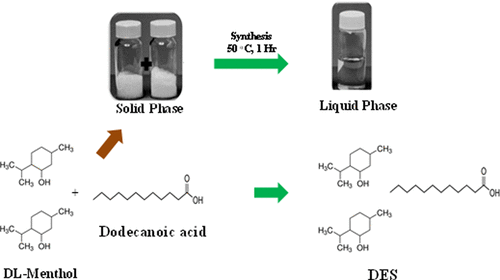当前位置:
X-MOL 学术
›
Ind. Eng. Chem. Res.
›
论文详情
Our official English website, www.x-mol.net, welcomes your
feedback! (Note: you will need to create a separate account there.)
Liquid–Liquid Extraction of Lower Alcohols Using Menthol-Based Hydrophobic Deep Eutectic Solvent: Experiments and COSMO-SAC Predictions
Industrial & Engineering Chemistry Research ( IF 3.8 ) Pub Date : 2018-02-23 00:00:00 , DOI: 10.1021/acs.iecr.7b05270 Rupesh Verma 1 , Tamal Banerjee 1
Industrial & Engineering Chemistry Research ( IF 3.8 ) Pub Date : 2018-02-23 00:00:00 , DOI: 10.1021/acs.iecr.7b05270 Rupesh Verma 1 , Tamal Banerjee 1
Affiliation

|
The lower alcohols tend to form azeotropic solution with water which makes the separation challenging. The current work primarily focuses on the synthesis and application of a menthol-based hydrophobic deep eutectic solvent (DES) for the removal of lower alcohols from its aqueous solutions. The DES is synthesized by the addition of DL-menthol and lauric acid (dodecanoic acid) with a molar ratio of 2:1. Liquid–liquid equilibria (LLE) experiments are then performed to evaluate the performance of the synthesized DES for the extraction of lower alcohols such as ethanol, 1-propanol, and 1-butanol. LLE corresponding to the pseudo ternary systems of lower alcohols (1-butanol, ethanol, and 1-propanol) + hydrophobic DES + water are measured at T = 303.15 K and p = 1 atm. The composition of the tie lines were evaluated using 1H NMR analysis for both extract and raffinate phases. Thereafter, the extraction efficiency of the DES is analyzed and compared by determining the solute distribution coefficients and the selectivity values. Finally, the experimental LLE data for the systems were regressed using the excess Gibbs free energy model, namely the Non Random Two Liquid (NRTL). Further the predictions of the tie lines were also confirmed through the COnductor like Screening MOdel Segment Activity Coefficients (COSMO-SAC) model. The average root-mean-square deviations (RMSD) obtained were 0.01 and 0.07 for NRTL and COSMO-SAC model, respectively.
中文翻译:

使用基于薄荷醇的疏水性深共熔溶剂液化萃取低级醇:实验和COSMO-SAC预测
低级醇倾向于与水形成共沸溶液,这使分离具有挑战性。当前的工作主要集中在基于薄荷醇的疏水性深共晶溶剂(DES)的合成和应用中,以从其水溶液中去除低级醇。DES是通过添加摩尔比为2:1的DL-薄荷醇和月桂酸(十二烷酸)合成的。然后进行液-液平衡(LLE)实验,以评估合成的DES萃取低级醇(如乙醇,1-丙醇和1-丁醇)的性能。在T = 303.15 K和p下测得与低级醇(1-丁醇,乙醇和1-丙醇)+疏水性DES +水的拟三元体系相对应的LLE。= 1个大气压。使用1 H NMR分析评估萃取线和萃余相的连接线组成。此后,通过确定溶质分布系数和选择性值来分析和比较DES的提取效率。最后,使用过量的吉布斯自由能模型,即非随机两种液体(NRTL),对系统的实验LLE数据进行了回归。进一步的联系线的预测也通过诸如筛选模型段活性系数(COSMO-SAC)模型的导体确定。对于NRTL和COSMO-SAC模型,获得的平均均方根偏差(RMSD)分别为0.01和0.07。
更新日期:2018-02-23
中文翻译:

使用基于薄荷醇的疏水性深共熔溶剂液化萃取低级醇:实验和COSMO-SAC预测
低级醇倾向于与水形成共沸溶液,这使分离具有挑战性。当前的工作主要集中在基于薄荷醇的疏水性深共晶溶剂(DES)的合成和应用中,以从其水溶液中去除低级醇。DES是通过添加摩尔比为2:1的DL-薄荷醇和月桂酸(十二烷酸)合成的。然后进行液-液平衡(LLE)实验,以评估合成的DES萃取低级醇(如乙醇,1-丙醇和1-丁醇)的性能。在T = 303.15 K和p下测得与低级醇(1-丁醇,乙醇和1-丙醇)+疏水性DES +水的拟三元体系相对应的LLE。= 1个大气压。使用1 H NMR分析评估萃取线和萃余相的连接线组成。此后,通过确定溶质分布系数和选择性值来分析和比较DES的提取效率。最后,使用过量的吉布斯自由能模型,即非随机两种液体(NRTL),对系统的实验LLE数据进行了回归。进一步的联系线的预测也通过诸如筛选模型段活性系数(COSMO-SAC)模型的导体确定。对于NRTL和COSMO-SAC模型,获得的平均均方根偏差(RMSD)分别为0.01和0.07。











































 京公网安备 11010802027423号
京公网安备 11010802027423号